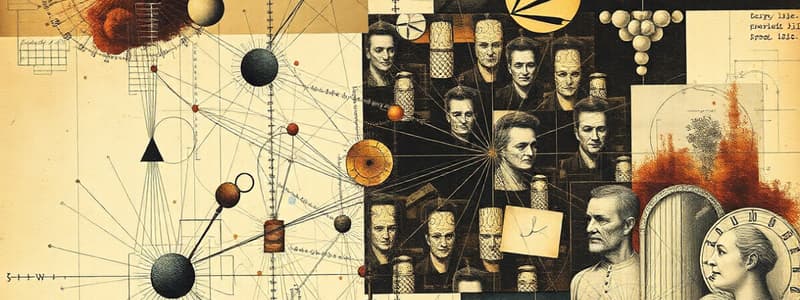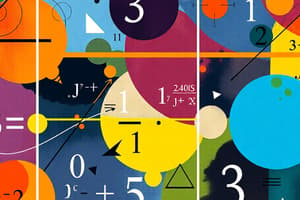Podcast
Questions and Answers
What is the focus of algebra in mathematics?
What is the focus of algebra in mathematics?
Algebra focuses on using symbols and variables to represent unknown quantities and solve equations and relationships.
Explain the concept of limits in calculus.
Explain the concept of limits in calculus.
Limits describe the behavior of a function as its input approaches a specific value.
What is the primary study area of number theory?
What is the primary study area of number theory?
Number theory primarily studies integers and their properties, including prime numbers and divisibility.
Describe the significance of matrices in linear algebra.
Describe the significance of matrices in linear algebra.
What role does probability play in statistics?
What role does probability play in statistics?
Flashcards
Arithmetic
Arithmetic
Deals with basic math operations: addition, subtraction, multiplication, and division.
Algebra
Algebra
Uses symbols and variables to represent unknowns and solve equations.
Geometry
Geometry
Studies shapes, sizes, and properties of figures.
Trigonometry
Trigonometry
Signup and view all the flashcards
Calculus
Calculus
Signup and view all the flashcards
Combinatorics
Combinatorics
Signup and view all the flashcards
Number Theory
Number Theory
Signup and view all the flashcards
Discrete Mathematics
Discrete Mathematics
Signup and view all the flashcards
Statistics
Statistics
Signup and view all the flashcards
Probability
Probability
Signup and view all the flashcards
Linear Algebra
Linear Algebra
Signup and view all the flashcards
Sets
Sets
Signup and view all the flashcards
Functions
Functions
Signup and view all the flashcards
Limits
Limits
Signup and view all the flashcards
Derivatives
Derivatives
Signup and view all the flashcards
Integrals
Integrals
Signup and view all the flashcards
Vectors
Vectors
Signup and view all the flashcards
Matrices
Matrices
Signup and view all the flashcards
Logic
Logic
Signup and view all the flashcards
Proof Techniques
Proof Techniques
Signup and view all the flashcards
Infinity
Infinity
Signup and view all the flashcards
Addition
Addition
Signup and view all the flashcards
Subtraction
Subtraction
Signup and view all the flashcards
Multiplication
Multiplication
Signup and view all the flashcards
Study Notes
Branches of Mathematics
- Arithmetic: Deals with basic operations like addition, subtraction, multiplication, and division.
- Algebra: Focuses on using symbols and variables to represent unknown quantities and solve equations and relationships.
- Geometry: Studies shapes, sizes, positions, angles, and properties of figures. Includes Euclidean, analytic, and non-Euclidean geometry.
- Trigonometry: Explores relationships between angles and sides of triangles, particularly useful in navigation and engineering.
- Calculus: Deals with rates of change and accumulation of quantities. Includes differential and integral calculus.
- Combinatorics: Studies the arrangements and combinations of objects.
- Number Theory: Studies integers and their properties, including prime numbers and divisibility.
- Discrete Mathematics: Focuses on mathematical structures that are fundamentally countable or discrete, such as graph theory and logic.
- Statistics: Deals with collecting, analyzing, and interpreting data.
- Probability: Measures the likelihood of events occurring, often described using proportions or percentages.
- Linear Algebra: Deals with linear equations and their applications, including concepts like matrices and vectors.
Key Mathematical Concepts
- Sets: Collections of objects. Includes set operations like union, intersection, and complement.
- Functions: Relationships between variables associating each input value to one unique output value.
- Limits: The behaviour of a function as its input approaches a specific value. Fundamental to calculus.
- Derivatives: Rate of change of a function. Essential in optimization problems.
- Integrals: The accumulation of quantities over an interval. Essential for finding areas and volumes.
- Vectors: Directed quantities having both magnitude and direction, often represented geometrically.
- Matrices: Arrays of numbers used to represent linear transformations or systems of equations.
- Logic: Deals with mathematical reasoning and arguments, often expressed using symbolic language.
- Proof Techniques: Methods used to prove mathematical statements, including direct, indirect, and proof by induction.
- Infinity: Concepts related to unbounded quantities, including different types of infinity and their applications in set theory.
Fundamental Mathematical Operations
- Addition: Combining two or more values.
- Subtraction: Determining the difference between two values.
- Multiplication: Repeated addition of a value.
- Division: Finding how many times one value is contained within another.
- Exponents: Repeated multiplication of a value by itself.
- Roots: Determining a value that when multiplied by itself a certain number of times equals another value.
Basic Mathematical Tools
- Calculators: Used for performing calculations rapidly and accurately.
- Computer software: Used for more complex calculations, simulations, and data analysis.
- Geometry tools: For drawing geometric shapes and making precise measurements, such as rulers, compasses, and protractors.
- Graph paper: For representing and analyzing relationships between variables.
Mathematical Problem Solving Strategies
- Identifying the problem: Clearly stating the question being asked and understanding the given information.
- Breaking down the problem: Dividing the problem into smaller, more manageable steps.
- Devising a plan: Creating a strategy to solve each step.
- Executing the plan: Implementing the strategy to find a solution.
- Evaluating the solution: Checking if the solution is correct, consistent with the given information, and reasonable.
- Seeking alternative solutions: Exploring different approaches to find the optimal or most efficient solution.
- Generalizing the solution: Identifying any patterns or broader applications of the solution methodology.
Studying That Suits You
Use AI to generate personalized quizzes and flashcards to suit your learning preferences.




